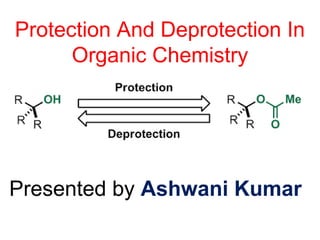
Protecting and Deprotecting groups in Organic Chemistry
- 1. Protection And Deprotection In Organic Chemistry Presented by Ashwani Kumar
- 2. Protecting groups for the amino group Why must an amino group be protected? N nucleophile acylation O N O- N + The most general way of masking nucleophilicity is by acylation. it reacts with electrophiles because it is a nucleophilic site it can be deprotonated by strong bases because it can contain acid protons
- 3. Protection of amino groups as carbamates 1) Carbobenzoxy group (CBz). The most widely used group is the carbobenzyloxy group (Cbz). O OCl + RNH2 O ORHN O ORHN H2/cat O NR2HO + +PhCH3 CO2 + HNR2 PhCH3 PROTECTION: DEPROTECTION: Because of the lability of the benzyl bond toward hydrogenolysis, the amine can be regenerated from a Cbz derivative by hydrogenolysis, which is accompanied by spontaneous decarboxylation of the resulting carbamic acid.
- 4. Protection of amino groups as carbamates 2) tert-butyloxycarbonyl (t-Boc) RNH2 R2NH O OO O O O OO N Ph CN R2N O O t-butoxypyrocarbonate 2-(t-butoxycarbonyloxyimino)-2-phenylacetonitrile BOC-ON PROTECTION: DEPROTECTION: CF3COOH, p-toluensulfonic acid
- 5. Protection of amino groups as amides a) phtalimides N O O R H2N NH2 RNH2 + HN HN O O NaBH4/EtOHaq N O R HO H H O RHN O BH4 - HO RHN O O O H2NR + PROTECTION: formation of the amide starting from the corresponding acyl chloride or anhydride DEPROTECTION: the use of these amides is characterized by the possibility of a cleavage in mild conditions
- 6. b) trifluoroacetamides O AcO OAcAcO AcO O NH COOEt O F3C O HO OHHO HO O NH2 COOH Ba(OH)2 18h, 25°C mild basic hydrolysis b) trichloroacetamides, benzamides O CCl3N H R NaBH4 ROH O CCl3N H R BH3 RNH2 + Cl3CHO O PhH2N R2AlH O PhR2N AlR R2NH + PhCHO partial reduction
- 7. b) sulphonamides NR2 S O O Ar + OMe OMe hν R2N - + ArSO2 + OMe OMe + photochemical cleavage 3) Allyloxy group The allyloxy group is removed by Pd-catalyzed reduction or nucleophilic substitution. These reactions involve liberation of the carbamic acid by oxidative addition to the palladium. The allyl-palladium species is reductively cleaved by stannanes, phenylsilane, formic acid and NaBH4.
- 8. O OR2N O OR2N Pd Bu3SnH O SnBu3R2N RNH2 + CO2 H Pd Pd 0 H2O Carbamic acid is removed by oxidative addition to palladium. The allylpalladium is then reductively cleaved by stannane
- 9. Protecting groups for the carbonyl group Why must a carbonyl group be protected? it reacts with nucleophiles because it is an electrophilic site it reacts with reducing agents because it can be reduced
- 10. Protection of carbonyl groups as acetals and thioacetals PROTECTION: acid catalysed formation of acetals O R'R + HC OMe OMe OMe MeO R' R OMe + O OMeH O R'R + OMe OMe MeO R' R OMe + O orthoester 2,2-dimethoxypropane acid catalysed exchange with a ketal + R'O R R OR' 2 O RR ROSiMe3 Me3SiO3SCF3 + Me3SiOSiMe3 trimethylsilyl trifluoromethylsulfonate DEPROTECTION: a)The carbonyl group can be deprotected by acid- catalyzed hydrolysis by the general mechanism for acetal hydrolysis LiBF4/CH3CN
- 11. b) non hydrolityc conditions (β-haloalcohols) DEPROTECTION (β-elimination): H+ + O RR OH HO Br O BrO R R 3-bromo-1,2-dihydroxypropane 2,2,2-trichloroethanol H+ + O RR CCl3HO OO RR CCl3Cl3C 2 PROTECTION: + O RR O BrO R R + O RR HO OO RR CCl3Cl3C Cl ClH H Zn Zn THF
- 12. c) non-acid conditions DEPROTECTION: + O RR 1,3-oxathiolanemercaptoethanol SH HO BF3 ∆/-H2O O S R R PROTECTION: O RR chloramine T O S R R Ni-Raney ROH O S+ R R CH3 S OO - N ClNa+ X H2O X =Cl or NSO2Ar
- 13. Protecting groups for the carboxyl group O OHR The carbonyl group can be protected in several ways The hydroxy group is generally protected as t-buthyl ester, that allows cleavage in acid conditions, or as 2,2,2-trichloroethyl ester, that can be cleaved in reductive conditions with Zn
- 14. a) oxazolidines DEPROTECTION: + O OHR HN O NR O N H R (+) N O R H+ 2,2-dimethylaziridine PROTECTION: HO NH2 N O R + O OHR 2-amino-2-methylpropanol The carboxylic acid group can be regenerated by acidic hydrolysis or converted to an ester by acid-catalyzed reaction with the appropriate alcohol.
- 15. a) ortho esters. Ortho esters derived from simple alcohols are very easily hydrolyzed, and a more useful ortho ester protecting group is the 4-methyl-2,6,7- trioxabicyclo[2.2.2]octane structure. These bicyclic orthoesters can be prepared by exchange with other ortho esters, by reaction with iminoethers, or by rearrangement of the ester derived from 3-hydroxymethyl-3- methyloxetan. R OMe OMe OMe CH3C(CH2OH)3 CH3C(CH2OH)3 BF3 NH OR'R O O O R O O OR 4-methyl-2,6,7-trioxabicyclo[2.2.2]octane exchange rearrangement
- 16. Protection of ester groups •In general, the methods for protection and deprotection of carboxylic acids and esters are not as convenient as those for alcohols, aldehydes, and ketones. O O O + Al S S Al SS a) cyclic b) acyclic O OR' R R + Al S S Al S S R2C •It is, therefore, common to carry potential carboxylic acids through synthetic schemes in the form of protected primary alcohols or aldehydes. •The carboxylic acid can then be formed at a late stage in the synthesis by an appropriate oxidation. •This strategy allows one to utilize the wider variety of alcohol and aldehyde protective groups indirectly for carboxylic acid protection.
